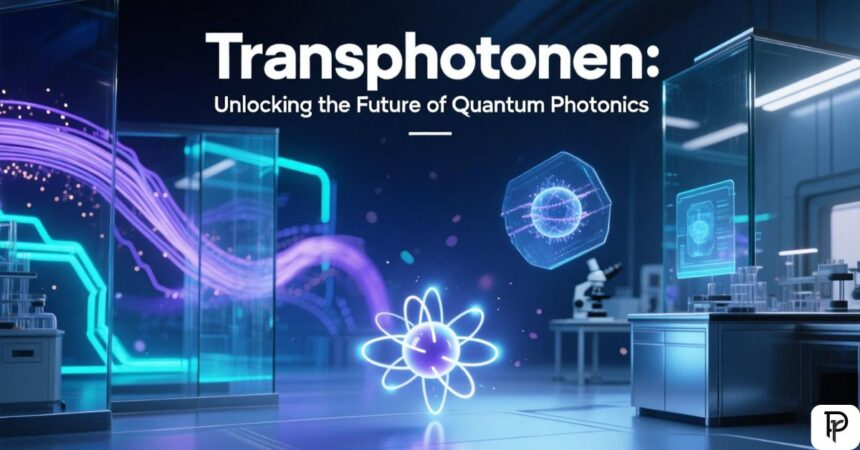In the rapidly advancing world of quantum photonics, Transphotonen is emerging as a groundbreaking concept that redefines how we use light. This light-based technology leverages the quantum properties of photons, such as photon entanglement and quantum coherence, to enable revolutionary applications.
From secure quantum communication to high-speed data transfer, Transphotonen holds the potential to transform industries like computing, healthcare, and defense. As researchers explore its possibilities, this innovative approach promises to push the boundaries of quantum information processing, paving the way for a future where light becomes the ultimate tool for communication and computation.
What is Transphotonen? A Beginner’s Guide
The term Transphotonen combines the Latin prefix “trans-,” meaning beyond, and the German word “photonen,” meaning photons. It describes advancements in photon manipulation that transcend traditional optical data transmission methods. Unlike conventional approaches, Transphotonen focuses on harnessing the unique properties of light at a quantum level, such as photon entanglement and superposition.
At its core, Transphotonen is about developing new systems that push quantum technologies into practical use. Applications range from secure quantum communication to the creation of the quantum internet, fostering an ecosystem where light facilitates unbreakable encryption and high-speed connectivity. This concept is still in experimental stages, but it’s gaining wide traction across global research hubs.
The Science Behind Transphotonen
The building block of Quantum photonics is the photon, a fundamental particle of light. At the quantum level, photons behave in ways that challenge classical thinking. For example, Non-locality allows two entangled photons to remain interconnected regardless of distance. This property fuels innovations like Quantum key distribution (QKD), essential for ensuring ultra-secure communication.
Transphotonen achieves advancements by leveraging these properties. By exploiting quantum coherence and spin and polarization control, scientists can develop Advanced optical systems capable of transmitting data at extraordinary speeds. These systems transition light from a purely classical utility to a source of quantum information, unlocking new computing and communication paradigms.

How Transphotonen Differs from Traditional Photonics
Traditional photonics rely on the classical properties of light—such as reflection and refraction—to transmit information. While effective in technologies like fiber optics, these methods have limitations in terms of speed and security. Transphotonen, however, expands these capabilities. By using quantum light systems, it introduces enhanced features like photon memory and entanglement-based communication, enabling unprecedented accuracy and reliability.
For instance, classical photonics cannot achieve the level of security that quantum encryption offers. Through Photon entanglement, any interference is immediately detectable, making eavesdropping nearly impossible. Furthermore, Transphotonen enables high-speed optical data transmission while minimizing loss over great distances, thanks to innovations like Quantum repeaters and Quantum transponders.
Technological Foundations of Transphotonen
The backbone of Transphotonen technology is its sophisticated hardware, such as Photonic integrated circuits (PICs). These circuits are pivotal for scaling quantum applications, replacing electricity with light in data processing. PICs ensure low-latency decision-making and minimized energy loss, opening doors to compact, energy-efficient designs.
Another key element involves quantum relay systems, such as Quantum repeaters. These devices ensure that quantum signals remain intact across long distances without degradation. Coupled with advancements in Silicon carbide photonic qubits, researchers are optimizing photon-based communication for faster, more robust systems.
| Key Components of Transphotonen Technology | Functionality |
| Photonic Integrated Circuits (PICs) | Enable processing of light-based signals |
| Quantum Repeaters | Maintain entangled states over large spans |
| Single-Photon Emitters | Emit precise, controllable light units |
| Quantum Transponders | Facilitate relay for quantum communication |
Applications of Transphotonen Technology
One major application of Transphotonen lies in creating the quantum internet, which promises unbreakable data transfer via global quantum networks. With its potential to eliminate latency and increase bandwidth, this internet could revolutionize industries reliant on real-time computing, like finance and healthcare.
Medical breakthroughs are also on the horizon. By incorporating ultrafast light imaging and quantum-enhanced MRI, Transphotonen can improve diagnostic precision. Similarly, Photon-based cancer detection promises less invasive, more accurate testing. Beyond medicine, the defense sector stands to benefit from Quantum radar, which detects stealth aircraft invisible to conventional systems.
Challenges and Limitations in Transphotonen Development
Despite its promise, Transphotonen faces challenges that slow widespread adoption. The technology is still in its infancy, with Quantum information processing requiring high levels of precision and stability. For instance, photon memory remains a technical hurdle, with current systems suffering from data retention inefficiencies.
Infrastructure costs are another obstacle. Building large-scale Advanced optical systems compatible with existing networks demands significant investment. Further complications arise when standardizing protocols across borders, creating issues of information inequality and inconsistent global adoption.
Recent Advances and Research in Transphotonen
Notable strides in Transphotonen research showcase its growing potential. For example, China’s Micius satellite demonstrated successful QKD over vast distances, while the European Quantum Flagship project is funneling billions into photonic innovations. These advancements highlight how international collaboration is critical for accelerating the technology.
American firms are also making headway. Startups like PsiQuantum are producing photon-based CPUs and GPUs, bridging the gap between theoretical science and practical quantum computing applications. These developments suggest that Moore’s Law—which dictates exponential advancements in technology—can be extended into the quantum era using Transphotonen.
Ethical and Security Implications of Transphotonen
The rise of Transphotonen comes with ethical concerns. For instance, Mass surveillance prevention must be addressed to ensure democratic uses of quantum encryption technologies. Furthermore, Dual-use risks—where advancements serve both civilian and military purposes—raise questions about controlling its deployment in conflict zones.
There’s also a need for global frameworks that ensure fair technology sharing. Without international cooperation, only a few nations might benefit, leading to further information inequality. Addressing these challenges transparently will be essential for building trust in Transphotonen’s applications.

The Future of Computing with Transphotonen
The future of Quantum computing is intrinsically tied to Transphotonen. Current systems face physical limitations, but light-based architectures offer a solution. With Photon-based CPUs and GPUs, complex tasks like machine learning, natural language processing, and global simulations could run quicker and cooler, driven by energy-efficient architectures.
Apart from technical efficiency, Global quantum networks promise seamless connectivity across industries, creating a more integrated digital landscape. By utilizing Spin and polarization control, these systems will usher in a new era of computing defined by speed, security, and sustainability.
Conclusion: Why Transphotonen Matters
Transphotonen is not just an academic concept; it represents a bold vision for how science can intersect with real-world challenges. Whether it’s enabling the quantum internet, enhancing medical diagnostics, or supporting green computing, its applications touch every corner of modern life. By addressing current barriers and investing in its development, scientists and governments alike can ensure Transphotonen fulfills its role as a technological game-changer. The future truly looks bright—brighter than any photon itself.
FAQs
- What is Transphotonen?
Transphotonen refers to advanced quantum photonics technology that manipulates photons for secure communication and high-speed data transfer. - How does Transphotonen differ from traditional photonics?
Unlike traditional photonics, Transphotonen leverages quantum properties like entanglement and superposition for enhanced performance. - What are the applications of Transphotonen?
It is used in quantum internet, secure quantum communication, medical imaging, and photon-based computing. - What challenges does Transphotonen face?
Key challenges include photon memory instability, high costs, and the need for global standardization. - Why is Transphotonen important for the future?
Transphotonen has the potential to revolutionize quantum computing, data security, and global communication networks.
